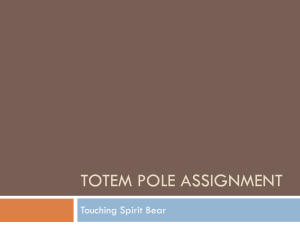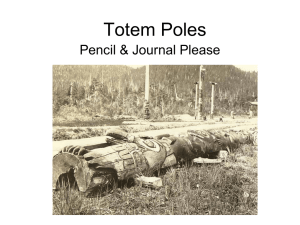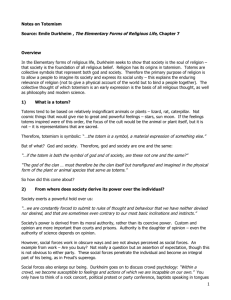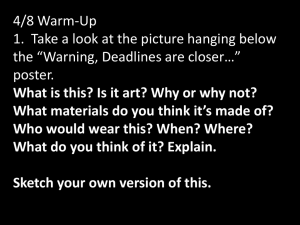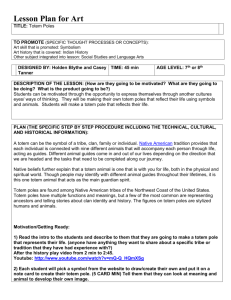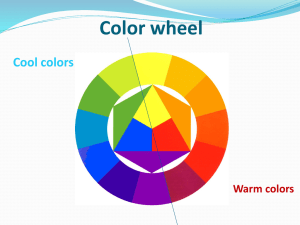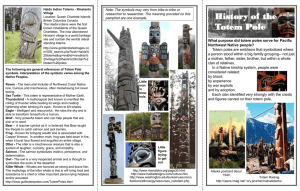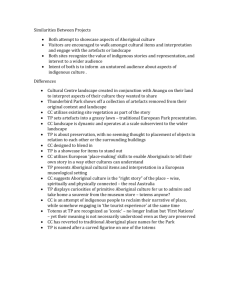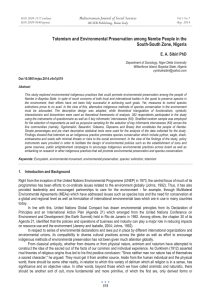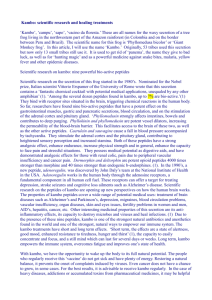Nurri Millen - a guide to the Indigenous art totems
advertisement
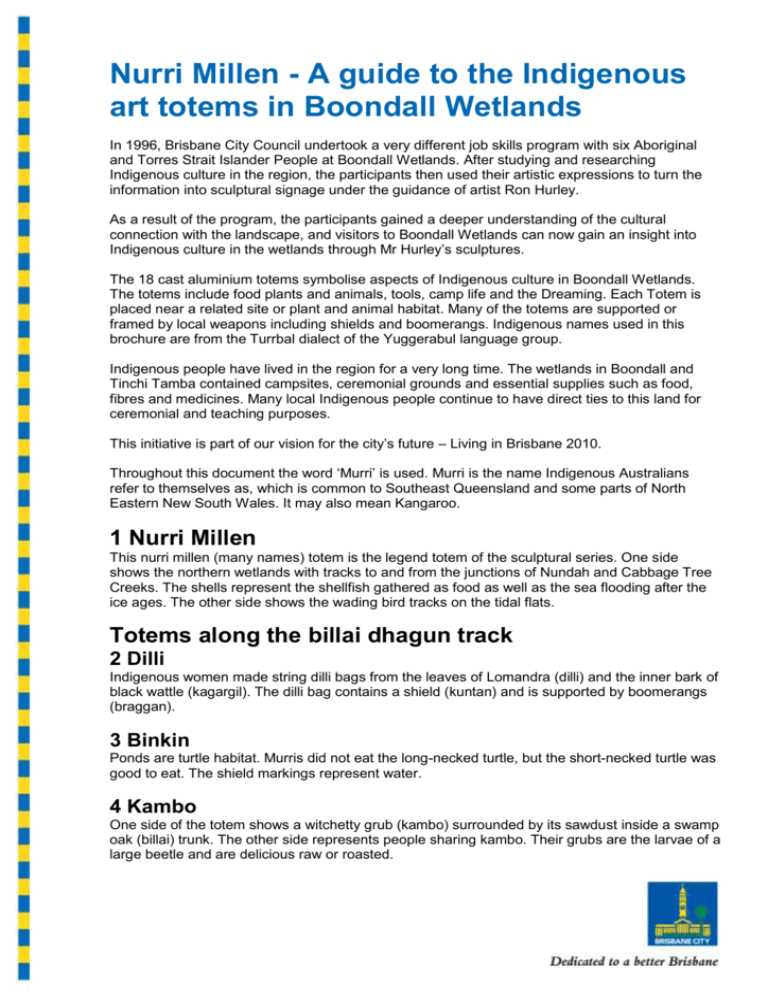
Nurri Millen - A guide to the Indigenous art totems in Boondall Wetlands In 1996, Brisbane City Council undertook a very different job skills program with six Aboriginal and Torres Strait Islander People at Boondall Wetlands. After studying and researching Indigenous culture in the region, the participants then used their artistic expressions to turn the information into sculptural signage under the guidance of artist Ron Hurley. As a result of the program, the participants gained a deeper understanding of the cultural connection with the landscape, and visitors to Boondall Wetlands can now gain an insight into Indigenous culture in the wetlands through Mr Hurley’s sculptures. The 18 cast aluminium totems symbolise aspects of Indigenous culture in Boondall Wetlands. The totems include food plants and animals, tools, camp life and the Dreaming. Each Totem is placed near a related site or plant and animal habitat. Many of the totems are supported or framed by local weapons including shields and boomerangs. Indigenous names used in this brochure are from the Turrbal dialect of the Yuggerabul language group. Indigenous people have lived in the region for a very long time. The wetlands in Boondall and Tinchi Tamba contained campsites, ceremonial grounds and essential supplies such as food, fibres and medicines. Many local Indigenous people continue to have direct ties to this land for ceremonial and teaching purposes. This initiative is part of our vision for the city’s future – Living in Brisbane 2010. Throughout this document the word ‘Murri’ is used. Murri is the name Indigenous Australians refer to themselves as, which is common to Southeast Queensland and some parts of North Eastern New South Wales. It may also mean Kangaroo. 1 Nurri Millen This nurri millen (many names) totem is the legend totem of the sculptural series. One side shows the northern wetlands with tracks to and from the junctions of Nundah and Cabbage Tree Creeks. The shells represent the shellfish gathered as food as well as the sea flooding after the ice ages. The other side shows the wading bird tracks on the tidal flats. Totems along the billai dhagun track 2 Dilli Indigenous women made string dilli bags from the leaves of Lomandra (dilli) and the inner bark of black wattle (kagargil). The dilli bag contains a shield (kuntan) and is supported by boomerangs (braggan). 3 Binkin Ponds are turtle habitat. Murris did not eat the long-necked turtle, but the short-necked turtle was good to eat. The shield markings represent water. 4 Kambo One side of the totem shows a witchetty grub (kambo) surrounded by its sawdust inside a swamp oak (billai) trunk. The other side represents people sharing kambo. Their grubs are the larvae of a large beetle and are delicious raw or roasted. 5 Murri Kangaroos (murri) were once common on the wetlands but are no longer found here. One side of the totem shows a waterhole with Eastern Grey Kangaroo tracks, the other side shows a kangaroo. As well as food, kangaroos provided rugs, sinew for stitching and tying and bone for tools and ornaments. 6 Du-wir Brown Quail (du-wir) live in the grass and were a favourite food. Women and children would beat the grass to flush out the birds and the men would bring them down with small hunting boomerangs. 7 Darlobolpal This totem represents Darlobopal (camp place with fire). The fish skeleton indicates that fish could be caught here and eaten. The other side shows swimming fish. The flames on the side and top represent the fireplace for cooking, warmth and light. 8 Gramman Flying foxes (gramman), a favourite Murri food, hang from boomerangs across a shield. They fly in to eat the fruits of these rainforest trees, dropping seeds of other plants. Their nearest camp is on Cabbage Tree Creek. 9 Wabbalkan The oval shapes represent bullroarers (wabbalkan), carved pieces of coast banksia wood that ‘roars’ when swung by string through the air. Bullroarers were used to ask permission to cross another tribe’s land, or to call children back to camp for dinner or bed. 10 Chibbur A colony of squirrel gliders (chibbur) lived around here. Gliders were a totem animal. The background design was used to decorate weapons and carrying vessels. The other side is hollowed out to show a squirrel glider’s silhouette. Totems along the bike track 11 Meeamee Crushed soap tree (meeamee) leaves made a lather for cleansing and they were also used to stun fish. The totem shows fish swimming, fish floating and the skeletons of fish caught and eaten. Eel shapes surround the top. 12 Chagine Eels (chagine) live in the creeks and were an important food. The markings on the shield are a typical local decorative motif. 13 Tabri Hunting and fighting clubs (tabri) were often made from grey ironbarks such as those growing nearby. Tabri come in many shapes and sizes. The wood was carved using sharp stones, then rubbed with beeswax and hardened in the fire. 14 Kuta Stingless native honey bees (kuta) rest on the side of a hive represented by two coolamons (niugum) placed together. Hexagonal patterns show honeycomb dripping with honey. 15 Ngurrun The grassland and woodlands were once emu (ngurrun) habitat. One side of the totem shows the emu and its tracks, the other side shows emu tracks leading to its nest. Emus were both a food and a totem animal. Emu feathers were used for decoration. 16 Kabul Carpet Pythons (kabul) were a food and totem animal. They are still common in the woodlands and forests. Totems at nudgee beach 17 Darlo Darlo (fire) crowns this totem framed by firesticks in their holders. The holders were made using grass tree resin and the sticks were from the cotton tree. Fire was women’s responsibility, and if the fire went out it was kindled by twirling the firestick in a hole cut into a piece of hard wood. 18 Mumbal Mumbal was the being who spoke with the voice of thunder. The clouds and lightening represent Mumbal who created the earth and everything on it. The hands in all directions represent the creator, the people and their respect. The totem was placed here in sight of the Glasshouse Mountains that are part of the Dreamtime creation story. For more information about other Council environment initiatives visit or phone (07) 3403 8888.
